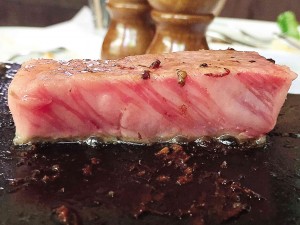Steak varieties worth one’s paycheck
When it comes to steak, Wagyu is recognized as the most indulgent.
Although I personally prefer a mean American Angus (still love the steak at Mamou), there is much to respect about Wagyu.
Marbling
For the connoisseur, it’s primarily the marbling. Wagyu meat has such distinctively pervasive marbling that it has been labeled the caviar of beef in Japan.
Marbling is the intramuscular fat that gives the meat a pattern that resembles marble. The fat keeps the meat moist and tender, giving it extra flavor and a silky texture. This texture is what some people refer to as butter-knife soft, i.e., steak so beautifully tender you won’t need a steak knife to cut it.
Achieving high grade marbling requires a meticulous process. Japanese cows weren’t just born that way (even if bloodline is an important element to great beef—more on that later.)
Cattle are bred for upward of 30 months (most USDA cattle are only around 22 months old) to accommodate a greater “fattening period” when the cows are made to eat frequently and generously.
There are also stories of the cows being massaged by “fattening farmers,” made to drink beer, and listen to classical music to relieve the cows of stress. These stories may be more fiction than fact, although it is true that Japanese Wagyu live a sedentary life, which contributes to better marbling as well.
The Japanese take this marbling competition so seriously that they even have a separate rating guide just for the marbling of beef, called a Beef Marbling Standard, the highest being 12.
Bloodline
Aside from fat content, the Japanese are also very strict about the cattle’s bloodline. Just as you can’t call sparkling wine “champagne” if it is found outside of the Champagne region, neither can you call beef “Kobe” unless it comes from the Tajima strain of wagyu cattle, raised in Japan’s Hyogo prefecture.
To avoid fakes, especially at the prices they charge for quality meat, the Japanese have also developed a numbering system that traces where each piece of beef is produced. The records are maintained by their National Livestock Breeding Center, and these show not only the cow’s origins but also its ancestry, birthplace, ranch location, and fattening days. Restaurants, generally, would also be able to share this information with you, as they are linked to the NLBC database. (It seems the Japanese data system for cows is better than the Philippines’ data system for voters.)
Best Wagyu
There are four Wagyu breeds: Black, which accounts for more than 90 percent of Wagyu beef; brown/red; shorthorn; and polled.
For the steak connoisseur, here are few of Japan’s best that you may like to take note of: Kobe, the most widely known kind of Wagyu, is beef that is distinctly from the black Tajima-ushi breed of cattle raised in the Hyogo prefecture; with meat coming from a bullock or castrated bull for purity reasons, and slaughtered at designated slaughterhouses in the prefecture.
Kobe beef has a marbling grade of at least 6. It is so soft that sometimes this beef is compared to foie gras.
While Kobe makes you think of foie gras, Kumamoto red wagyu cattle from the southern island of Kyushu makes its tasters think of oysters. Although its cattle are the only free-grazing cattle in Japan, this kind of Wagyu is known for its intense buttery flavor and extreme tenderness.
Matsuzaka is beef from the Mie prefecture. While Kobe uses bullocks, Matsuzaka uses only female cows, which are not slaughtered until they are three years old. The result is beef that is more complex and flavorful. This kind of meat is so delicate that it is often served raw, as either sashimi or sushi.
Omi (sometimes spelled Ohmi) is from cattle that was raised in the Shiga prefecture, whose marbling offers a sweet flavor.
Saga, considered one of the “big three” in Japan, along with Kobe and Matsuzaka, is from the Saga prefecture on the northwest part of Kyushu island. Aside from the prefecture’s perfect environment, with pure water and clean air, Saga farmers also use a special calf-rearing technology to ensure that the cow suffers no stress at all.
House of Wagyu
Omi and Saga beef are available at Wagyu, a Japanese beef deli at Sunvar Plaza in Milelong, Makati. The best Japanese meats are available here for purchase at approximately P1,400/100 grams.
You also have the option to dine at this Japanese meat deli, but parking is a challenge. A fly might present itself as company, while the seats are limited seats (stools on the ground floor
and Japanese-style seating upstairs). Also, the stone grill they use makes for a messy meal. Best to take out and appreciate the beef at home. Anyway, the beef will speak for itself.
For a full fine dining experience with Saga beef, head over to House of Wagyu (branches in Greenhills, Eastwood, Podium, and at Two E-Com Building at the Mall of Asia complex).
House of Wagyu has distinguished itself with their signature stone grills.
Corinne Castañeda, the Lady of the House, had the grills customized specifically for their Wagyu steaks. They are made from Japanese volcanic stones that sear the Wagyu perfectly. The restaurant keeps the stone grills in the oven for hours, so when customers order, they are placed before you piping hot.
This restaurant has always used Australian-bred Wagyu beef, i.e., from Japanese cattle but bred in Australia. This year, they started offering Saga beef (grade A4, BMS 5-7).
I agree with using this grade because an A5 (with a BMS of 10-12), while absolutely indulgent, is just practically all fat. An A4 offers the beautiful silkiness for the steak without losing the presence of the meat.
At this restaurant, you will see the gorgeous marbling of the steak in its raw state as it is served to you (because you will cook it yourself on the stone grill). When you take a bite, you will realize why it is so special. It is really so soft, so gentle, so delicate yet with a definitive flavor … just divine.
It is not cheap, though, at P5,300 for 220 grams for a rib-eye and P4,800 for sirloin. But that is the price of quality. After all, you’re not just paying for ordinary beef, but possibly for the Vienna Philharmonic Orchestra’s royalties for rendering Beethoven which the cow listened to as it de-stressed and developed perfectly spread out fat.
Seriously, though, this is really the connoisseur’s steak. And for that special occasion (like next month’s Father’s Day), it’s worth the splurge.
Back in 1987, House of Wagyu owner Melo Santiago introduced Certified Angus Beef to the Philippine market at Melo’s steakhouse. Nearly thirty years later, as he introduces Saga by way of House of Wagyu, Melo proves that he is still at the top of his game.
House of Wagyu
2Ecom Building, Harbour Drive, Mall of Asia Complex, Pasay. Reservations recommended. Call. +632 553-8437, +63 917 834-1248. Wheelchair accessible. Major credit cards accepted. Other branches: Greenhills, Podium, Eastwood. Visit their Facebook page: House of Wagyu.
Follow @margauxsalcedo on Twitter, Facebook, Instagram. Visit margauxsalcedo.com.
















